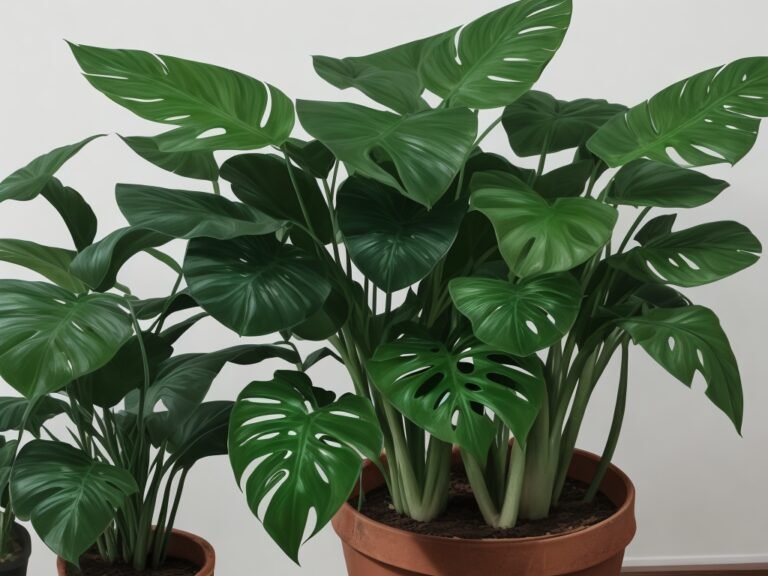How To Revive a Drooping Monstera Plant?
Key Takeaways:
- Check the soil moisture level regularly.
- Adjust the watering schedule as per the plant’s needs.
- Place the plant in a well-lit area, but away from direct sunlight.
- Prune any dead or yellowing leaves to promote new growth.
Are you feeling a sense of dread as you look at your drooping Monstera plant, wondering if there’s any hope left?
Don’t worry, I’ve got you covered! In this article, I will guide you through the steps to revive your precious Monstera and bring it back to life.
We’ll explore the common characteristics of a healthy Monstera, signs of a drooping plant, and the possible causes behind it.
I’ll also share expert tips on adjusting watering and humidity levels, assessing lighting conditions, examining the soil, and providing proper support.
Plus, I’ll give you some valuable advice on ongoing care and preventative measures to keep your Monstera thriving.
Let’s dive in and revive your drooping Monstera together!
| Problem | Solution |
| The leaves are drooping and wilted. | – Check the soil moisture – Water the plant – Ensure proper drainage – Mist the leaves – Increase humidity |
| The plant is receiving insufficient light. | – Place the plant near a window – Provide indirect sunlight – Use grow lights |
| The plant is root-bound. | – Repot into a larger pot – Trim the roots – Replace the old soil |
| Overwatering | – Reduce watering frequency – Allow the soil to dry between waterings |
Understanding the Monstera plant
The Monstera plant is a popular indoor plant known for its large, fenestrated leaves and vining growth habit.
An introduction to the Monstera plant
The Monstera plant, also known as the Swiss cheese plant, is a popular choice among houseplant enthusiasts.
It features large, glossy leaves with distinct splits and holes, giving it a unique and tropical appearance.
This plant is native to the rainforests of Central and South America and is known for its ability to adapt to indoor conditions.
It can thrive in various lighting conditions and requires moderate care.
Overall, the Monstera plant is not only visually appealing but also relatively easy to care for, making it a great addition to any plant lover’s collection.
Common characteristics of a healthy Monstera plant
A healthy Monstera plant should have lush, green leaves with no discoloration or yellowing. The leaves should be firm and not drooping.
It should also have sturdy stems and nodes with aerial roots.
The plant should be growing steadily and producing new leaves regularly.
Identifying a drooping Monstera plant
To identify a drooping Monstera plant, look out for wilted, limp leaves and a general lack of turgidity in the plant’s overall appearance.
Signs of a drooping Monstera plant
A drooping Monstera plant may show signs such as wilting or limp leaves, sagging stems, and a generally sad and unhealthy appearance. The leaves might also turn yellow or brown and develop dry, crispy edges.
It’s important to identify these signs early to take proper action and revive your plant.
Possible causes of drooping
A drooping Monstera plant could be caused by several factors.
These include overwatering or underwatering, improper humidity levels, inadequate lighting, root issues, and lack of support.
It’s important to identify the root cause to properly revive the plant.

Reviving a drooping Monstera plant
Is your Monstera plant looking sad and droopy? Follow these steps to revive it and get it thriving again!
Identifying the root cause
To identify the root cause of your drooping Monstera plant, you’ll need to assess several factors.
Firstly, check the soil moisture and make sure you’re not over or under-watering.
Secondly, evaluate the lighting conditions to ensure your plant is getting enough but not too much light.
Thirdly, examine the soil quality and consider repotting if necessary.
Lastly, inspect the plant for any signs of pests or disease.
By exploring these aspects, you can determine what’s causing the drooping and take appropriate actions to revive your Monstera.

Adjusting watering and humidity levels
Adjusting watering and humidity levels is crucial for reviving a drooping Monstera plant. Water less frequently and make sure the soil is well-draining.
Increase humidity by misting the leaves or using a humidifier.
Monitor the moisture levels and adjust accordingly to promote healthy growth.
Assessing the lighting conditions
To assess the lighting conditions for your Monstera plant, observe the amount of light it receives during the day.
Monstera plants thrive in bright, indirect light, so ensure it receives enough light without being exposed to direct sunlight.
If the leaves are pale or yellowish, it may be receiving too much light.
On the other hand, if the leaves are dark green and small, it may not be receiving enough light.
Adjust the plant’s placement accordingly to provide it with optimal lighting conditions.
Examining the soil and repotting if necessary
Examining the soil is essential when reviving a drooping Monstera plant. Check if the soil is too wet or too dry.
If it’s waterlogged, repot the plant in fresh, well-draining soil.
Ensure the new pot has proper drainage holes. Avoid using pots that are too big; choose one that is only slightly larger than the current pot.
This helps prevent overwatering and promotes healthy root growth.
Pruning and providing proper support for the plant
To prune a Monstera plant, remove any yellow or wilted leaves, as well as any branches that are growing in an undesirable direction.
Provide support for the plant by using stakes or a moss pole, which the Monstera can climb as it grows.
Regularly check and adjust the support as needed to ensure proper growth and stability.

Providing ongoing care for a Monstera plant
To care for your Monstera plant, make sure to water it properly, maintain optimal humidity levels, provide the right lighting conditions, fertilize it regularly, and prevent common issues and pests.
Proper watering techniques
Water your Monstera plant thoroughly when the top inch of soil feels dry.
Use room temperature water and pour it evenly across the soil until it begins to drain out of the bottom of the pot.
Avoid overwatering, as this can lead to root rot.
Monitor the soil moisture regularly and adjust watering frequency accordingly.
Ensure good drainage and allow the soil to partially dry between waterings.
Maintaining optimal humidity levels
Maintaining optimal humidity levels is crucial for the health of your Monstera plant.
To keep humidity levels in check, you can:
- Place a humidifier near your plant or use a pebble tray with water.
- Mist the leaves regularly.
- Group your plants together to create a microclimate.
- Avoid placing your Monstera near air vents or drafts.
Choosing the right lighting conditions
Choosing the right lighting conditions is essential for the health of your Monstera plant. It thrives in bright, indirect sunlight, so place it near a window with filtered light.
Avoid direct sunlight, as it can burn the leaves.
If you don’t have enough natural light, you can supplement with artificial grow lights.
Fertilizing and feeding the plant
To ensure healthy growth and development, it’s important to fertilize and feed your Monstera plant. Use a balanced liquid fertilizer once a month during the growing season (spring and summer).
Dilute the fertilizer according to the instructions, and apply it to the soil.
Also, consider adding organic matter, like compost, to enrich the soil. Avoid over-fertilizing, as it can lead to root burn.
Regular feeding will provide the necessary nutrients for your Monstera to thrive.
Preventing common issues and pests
To prevent common issues and pests with your Monstera plant, it’s important to pay attention to its needs and create a healthy growing environment.
Here are a few tips:
- Provide proper drainage: Ensure that your plant’s pot has drainage holes to prevent water from accumulating and causing root rot.
- Avoid overwatering: Only water your Monstera plant when the top inch of soil feels dry. Overwatering can lead to root rot and other issues.
- Maintain appropriate humidity levels: Monstera plants thrive in moderately high humidity. Consider using a humidifier or placing a tray of water near the plant to increase humidity.
- Keep the leaves clean: Dust can accumulate on the leaves, hindering their ability to absorb sunlight. Gently wipe the leaves with a damp cloth to keep them clean.
- Provide adequate light: Monstera plants require bright, indirect light. Avoid placing them in direct sunlight, as it can scorch the leaves.
- Protect from drafts: Avoid placing your Monstera plant near drafty windows or doors as it can stress the plant.
- Monitor for pests: Regularly check your plant for signs of pests such as spider mites or mealybugs. If you notice any, treat them promptly using the appropriate insecticide or natural remedies.
Frequently Asked Questions
Can a severely drooping Monstera plant be saved?
Yes, a severely drooping Monstera plant can be saved. By identifying the root cause, adjusting watering and humidity levels, assessing lighting conditions, examining the soil, pruning, and providing proper support, you can revive your plant.
Ongoing care and attention are crucial for its sustained health.
How often should I water my Monstera plant?
Water your Monstera plant when the top inch of soil feels dry to the touch. Stick your finger into the soil or use a moisture meter to check.
Generally, you’ll need to water it about once every 7-10 days, but it depends on factors like humidity, season, and the size of the plant.
Avoid overwatering by ensuring the soil has proper drainage.
Can I revive a drooping Monstera plant with just water?
Yes, you can revive a drooping Monstera plant with just water, but it’s not the only solution. Watering alone may not address the underlying causes of the drooping, such as improper watering, lighting, or soil conditions.
It’s important to thoroughly assess and adjust these factors to help your plant recover.
What can I do if my Monstera plant is too big and drooping?
If your Monstera plant is too big and drooping, there are several things you can do.
First, identify the root cause, such as overwatering or insufficient lighting.
Adjust watering and humidity levels accordingly.
Assess the lighting conditions and provide adequate light.
Examine the soil and consider repotting if needed.
Prune the plant and provide proper support.
Finally, provide ongoing care by watering correctly, maintaining optimal humidity, choosing the right lighting, fertilizing, and preventing common issues and pests.
How long does it take for a drooping Monstera plant to recover?
It can take anywhere from a few days to a few weeks for a drooping Monstera plant to fully recover.
The recovery time depends on the severity of the drooping and the actions taken to address the underlying issues.
By identifying and addressing the root cause, adjusting watering and humidity levels, assessing lighting conditions, and providing proper care, you can help speed up the recovery process.
Patience and consistent care are key in helping your Monstera plant regain its health and vitality.
Can I use fertilizer to revive a drooping Monstera plant?
Yes, you can use fertilizer to help revive a drooping Monstera plant. Fertilizer provides essential nutrients that can promote growth and improve overall plant health.
However, it’s important to identify the root cause of the drooping first and address any underlying issues before fertilizing.
Proper watering, humidity levels, lighting conditions, and pruning are also crucial for the plant’s revival.
Final Verdict
Reviving a drooping Monstera plant requires careful assessment and targeted adjustments to its care. By identifying the root cause, adjusting watering and humidity levels, assessing lighting conditions, examining the soil, and providing pruning and support, you can revive your plant and ensure its long-term health.
Ongoing care, including proper watering techniques, optimal humidity levels, suitable lighting conditions, and regular fertilizing, will help prevent future drooping.
With patience and attention, your Monstera plant will thrive and become a beautiful and vibrant addition to your home.






